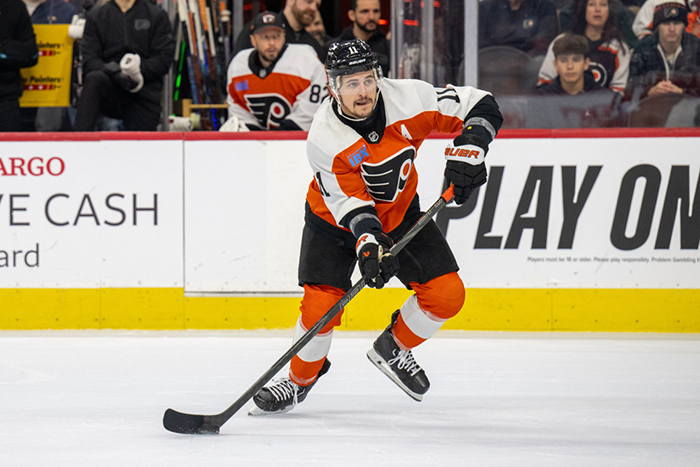Anthony Mingioni’s Flyers blogs are powered by Phans of Philly and by Summit Public Adjusters. Have you experienced damage to your property? Don’t panic! You’re in good hands. Summit works for YOU, and not the insurance companies. Call Brendan Gillespie at 215-919-1434. Phans of Philly is the longest-established travel company for Philadelphia pro sports team fan road trips.

October proved to be full of early season surprises for the Philadelphia Flyers. Initially looking at a dire situation on defense with Cam York out with a lower body injury and a difficult opening slate of games, the Flyers emerged from it in relatively good shape.
They’ve won six of their first ten games of the season (6-3-1) and currently hold the top Eastern Conference Wildcard position. They’re bolstered by vastly improved goaltending thanks to Daniel Vladar.
Add to the mix, the Flyers have flustered opposing power plays on a consistent basis, as their penalty killing units rank third in the league at 89.2 percent.
At the same time, they’ve taken advantage of a heavy home slate of games with all six wins coming at the Xfinity Mobile Arena. With a heavier road schedule awaiting them in the coming months, can the Flyers maintain their early season momentum?
When the season began, Flyers Thoughts posited five questions that the team faced entering the season. With that in mind, let’s take a look at how the Flyers answered them.
With Cam York Out, How Does The Defense Manage?
As it turned out, pretty decently. After York missed the first three games of the season, he returned to the Flyers lineup. As expected, he and Travis Sanheim have looked every bit of a reliable first pairing, with the former tallying five assists in seven games.
Even more important has been the emergence of the Jamie Drysdale and Nick Seeler partnership. Both pairings have given the Flyers a very competitive top four.
According to MoneyPuck.com, Sanheim and York have an Expected Goals Against (per 60 minutes) of 1.74, which is seventh overall amongst defensemen. Drysdale and Seeler are 1.94, good for 11th.
Where the Flyers are still in “seek and find” mode is their third pairing.
Egor Zamula, Adam Ginning, Noah Juulsen, and Emil Andrae are jockeying for regular minutes.
Zamula has looked better of late, while Juulsen has the benefit of being a sizable safe type. But if the Flyers are looking to push transitional play from all three pairings, Andrae would seem their best long term option.
However with Jacob Gaucher on recall with Sean Couturier injured, the Swede remains with the Phantoms on standby.
How Often Does Jett Luchanko and Nikita Grebenkin Draw In?
Grebenkin, acquired last season from Toronto in the Scott Laughton trade, was one of the highlights of the Flyers preseason and remains a versatile component.
But there is still a learning curve for him, as Tocchet reiterated on Saturday when asked by reporters. He currently has one assist and is a minus four.
Of late, he has rotated on the fourth line with Nicolas Deslauriers, alongside Rodrigo Abols and Garnet Hathaway.
His willingness to engage physically and provide necessary speed for that unit will allow him to continue to factor in the lineup.
Unfortunately for Luchanko, his uneven preseason carried over to the regular season. He showed a reticence to shoot the puck more often. Combined with uneven defensive zone efforts, he lost his grip on a lineup spot.
As a result, he was sent back to the Guelph Storm in the OHL this past week.
The question for Luchanko is how long will he remain in Guelph, even if the club named him co-captain?
How Does Tocchet Mix and Match Lines?
While this is expected in the early going, there are certain personnel grouping that Tocchet has shown he trusts.
Consequently, the group that has earned that trust is Noah Cates’ line with Tyson Foerster and Bobby Brink. They’ve showed the same chemistry, puck possession, and forechecking prowess as they did late last season.
In many ways, they’ve amped up their offensive production and become a vital part of the team’s improved power-play performance. As a unit, they had a combined nine goals and 20 points during October.
Additionally, Christian Dvorak’s versatility has been a major help for the Flyers in the early going. He has found a home as their third line center between Trevor Zegras, the team’s leading scorer, and Michkov.
Tocchet toyed with a Zegras and Michkov line pairing during the preseason, but it became a reality when the Russian struggled to produce. Partnered with Zegras, Michkov appears to be emerging again offensively.
Speaking of Zegras, after three games playing at the center position, Tocchet has placed him in a “hybrid” role playing the left wing predominantly. He has emerged as one of the Flyers most potent offensive threats with 12 points (four goals, eight assists) in 10 games and a dangerous trigger on the power play.
With Couturier likely still out of the lineup on Saturday against the Toronto Maple Leafs, it appears that Zegras will play center between Michkov and Owen Tippett.
Speaking of Tippett, his impressive opening (with a team leading five goals) has him getting top line minutes. Whether this performance finally becomes his baseline is the question.
Can Ersson and/or Vladar Get Off To Good Starts?
One of the biggest issues from last season was the feeling that the goaltending were asked to handle a load that they weren’t capable of.
However, the coaching staff has the firm belief that the Box Plus One system will lessen that load over the course of the season, the question was whether Ersson or Vladar could thrive.
Vladar has done more than that, as he is fourth in the league in goals against average (1.67) and third in save percentage (.939). It’s not just the numbers, it’s his ability to make critical game saving stops for a team that is still finding itself offensively with.
As a result, Vladar currently hold the edge on Ersson for starter’s minutes, especially while the latter has a 3.08 GAA and an .876 save percentage.
That being said, Ersson was actually solid and earned back to back starts against the Islanders last Saturday and the Penguins on Tuesday. However, he incurred a lower body injury that puts him on the shelf through the mid-way point of next week.
Phantoms goalie Aleksei Kolosov was recalled and is expected to start a game while Ersson is out, likely Sunday against Calgary.
In the modern NHL, if a team can have two goalies who can provide good performances, it changes everything for the players in front of them. If the Flyers have any hope of contending for a postseason berth, the performance of their goalies will be a big reason why.

Can The Power Play Click Early?
While the power-play has scored six times in 30 attempts so far (20 percent), that might not seem like a cause for celebration. But much like Ancient Rome, the rebuilding of it wasn’t going to happen in a day.
Tocchet, along with assistant coaches Yogi Svejkovsky and Jay Varady, have a preference for a four forwards, one defenseman set up on the power play units.
And when you add high skill players like Zegras to the mix in a marriage of solid concepts, being ranked 18th in the NHL is a marked improvement. Especially from the past few seasons where the Flyers were among the league’s worst with the man-advantage.
Conceptually, the Flyers head coach believes that a lot of power-play goals are generated as much due to causing chaos as pinpoint passing.
It’s entirely possible that’s the reason why the Flyers second unit with the relentless Cates line paired with York and Zegras have had more success (four of the team’s six goals) than the top unit led by Sean Couturier and Matvei Michkov.
So while we can’t say the power-play is “clicking” just yet, if Drysdale can hew closer to York’s level at the point, perhaps they’ll continue their ascent.



